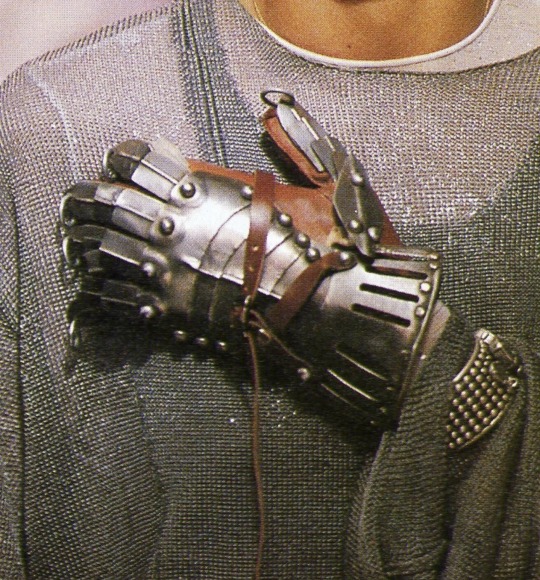#Glove
Explore tagged Tumblr posts
Text

Boots Gloves & Corset
22 notes
·
View notes
Text

Jean Paul Gaultier spring/summer 1994
5K notes
·
View notes
Text

source: unknown
282 notes
·
View notes
Text

Children in the artist's workshop by August Friedrich Siegert
#august friedrich siegert#art#artist#workshop#studio#children#armour#chair#items#furniture#german#germany#painter#painting#europe#european#halberd#axe#axes#sword#swords#glove
230 notes
·
View notes
Photo

by Meret Oppenheim
269 notes
·
View notes
Note
hello!
to start off, i just wanna say that i love your blog and it has been a wonderful archive and resource for kimono and japanese fashion history!
on that note, i was wondering if you happen to know about these tight sleeves worn by the main characters on jidaigeki? (circled in red)


someone on reddit suggested that it could be a strip of sarashi wrapped around the arm, while this ask here said it could be a juban with its long sleeves bounded tightly (they did provide a link which is now unfortunately no longer available).
i was just wondering which is correct, and if these sleeves are historically accurate?
thank you! ☺️
Hi! Thank you for your kind words <3
Well technically one could use fabric strips to wrap arms (and legs), but it's dubious this would have been done unless you were a rag-wearer of some kind. This is inconceivable in a formal setting (first pic), and for well-off samurai (second pic).
To my knowledge, juban would not have been used like this either. Wrapping them would have looked wonky and felt uncomfortable considering juban tailoring.
Arm wrappers are in fact a whole category of "traditional" clothing, and generally called 手甲 tekkou, which designates any mittens-like arm bracers, tied with strings and/or kohaze clasps.

Variations existed:
in length, for example 半手甲 wrist to elbow / 長手甲 wrist to upper arm often tied together on the bust
with or without part covering backs of hands, coming in different shapes and styles, attached or not with a loop around middle finger (山付き手甲, 手甲付き手筒).



Similar attire existed for legs, in form of gaiters/leg warmers called 脚絆 kyahan.

(find more, including another "sexy" kyahan pic, and how to put them on here)
As a side note, vocab around mitten-like clothing can be confusing:
手甲 Tekkou, is the generic term for anything covering the arms and hands, including gauntlet/armored ones (which I know under the term 籠手 kote)
But you can also find the word 腕貫 udenuki = arm tube, which can made from several materials like rattan/bamboo (worn under sleeves to keep fresh during summer, or above them to protect sleeves when writing with a brush), or made from fabric (and used for warmth, to keep dirt away, etc. Also called 腕袋 udebukuro)



Nowadays, both tekkou and kyahan are still super common sight during matsuri, as they are part of the attire of mikoshi bearers and taiko drumers (see this shop here and here):



Hope this helps :)
#ask#Fashion history#Historical fashion#tekkou#tekko#bracer#mitten#glove#arm#kyahan#gaiter#leg warmer#arm warmer#ninja gloves#kote#armored bracer#udenuki#udebukuro#arm tube#kimono arm warmer#着物
232 notes
·
View notes
Text

Miguel Adrover fw12
102 notes
·
View notes
Text

87 notes
·
View notes
Text




#京#Dir en grey#ghoul#makeup#glove#screenshots#Kyo#tour23 Phalaris vol II#Phalaris#skull#sorry but I see a parallel with Art in Terrifier here#but I guess a bloodied white glove can be anything really
69 notes
·
View notes
Text

Leather glove
228 notes
·
View notes
Text

Sonia Rykiel autumn/winter 2006
725 notes
·
View notes
Text


NEW !!! OFF WHITE OVER-SIZED GLOVE. NOW AVAILABLE, use code: ENID30 for 30% off at checkout!
PURCHASE HERE
#fashion#avant garde#design#style#high fashion#art#haute couture#fashion editorial#highfashion#houseofenid#glove#oversized
46 notes
·
View notes
Text

やっぱり熱いでしょう? by シロネコバン
110 notes
·
View notes
Text

Lucky the digital Bun.
Happy Birthday @polygoncherub!
#daily comic#Anthro#sci-fi#Cyberpunk#glove#hologram#bun#bunny#Lucky#polygoncherub#happy birthday#gift art
24 notes
·
View notes
Text

www.instagram.com/officialnatalina
81 notes
·
View notes
Text

Cody Foster 3.75In Gardening Gloves, Glass, Growing ebay Story Book Kids Gift Shop
26 notes
·
View notes